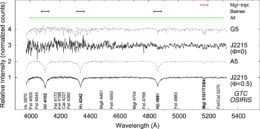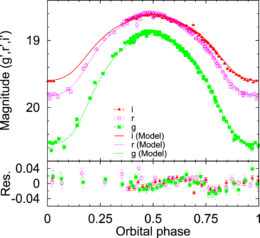How massive can a neutron star get? In a recent study, scientists may have identified the most massive neutron star yet — by leveraging observations of its highly irradiated companion.
Finding the Maximum
The maximum possible mass for a neutron star is a topic of heated debate; knowing this limit could put significant constraints on models of neutron-star interior structures and compositions, which are longstanding open questions in neutron-star studies.
Until now, the most massive known neutron star was pulsar PSR J0348+0432, which weighs in at 2.01 solar masses. For years, scientists have been on the hunt for other massive neutron stars to push this limit even higher — and now, J0348 may finally have been dethroned.
Led by Manuel Linares (Polytechnic University of Catalonia and the Canary Islands Institute of Astrophysics, Spain), a team of scientists has used a unique approach to measure a new, intriguing heavyweight: PSR J2215+5135.
A Tricky System

The spectra of J2215 look drastically different at different phases in its orbit: when we view its hot, irradiated side (bottom spectrum), it looks like an A5 star (2nd spectrum from bottom). When we view its dark, cool side (3rd spectrum from bottom), it looks like a G5 star (4th spectrum from bottom). [Linares et al. 2018]
How can we measure PSR J2215’s mass? Ordinarily, we’d use the spectra of its companion star to identify Doppler shifts of absorption lines from the star’s atmosphere. This can reveal the star’s radial velocity, ultimately allowing us to model the system and obtain the masses of the neutron star and its companion. But PSR J2215 has thus far resisted such efforts, with different studies all finding significantly different radial-velocity measurements for the companion star. What’s going on with this tricky system?
New Champion Crowned
Linares and collaborators have an explanation: the companion star is being positively blasted with radiation by the nearby pulsar. As a result, the star effectively has two sides: the cool, dark side facing away from the neutron star, and the extremely hot, irradiated side facing toward it. The offset of the companion’s center of light from its center of mass complicates efforts to reliably measure its radial velocity from its spectrum.
Linares and collaborators circumvent this problem by using high-quality optical spectra from the Gran Telescopio Canarias and other telescopes to identify, for the first time, absorption lines from both the cool side and the hot side of the companion star. The authors use these lines from opposite sides of the star to bracket the center-of-mass velocity.By jointly modeling both the radial-velocity data for the two star sides and the light curves in multiple bands, the authors are able to calculate the mass of the neutron star and its companion, respectively ~2.3 and ~0.33 solar masses. If verified, PSR J2215 would shatter the past record for maximum neutron-star mass, introducing new constraints to models of neutron-star equations of state.
What’s more, the authors’ novel technique for extracting the neutron star’s mass can be applied to many similar known systems, as well as the many we expect to discover in the future. With luck, we’ll be able to continue to push the limit of the maximum neutron-star mass, learning about these compact beasts in the process.
Citation
M. Linares et al 2018 ApJ 859 54. doi:10.3847/1538-4357/aabde6


7 Comments
Pingback: The Aftermath of GW170817: Neutron Star or Black Hole?
Pingback: Astronomers Just Found the Largest Known Neutron Star | Unhinged Group
Pingback: Astronomers Just Found the Largest Known Neutron Star | Aquaiver IT Solutions
Pingback: Astronomers Just Found the Largest Known Neutron Star | USASpeaks.com
Pingback: 10 Amazing Acts Of Stellar Chaos – Top 10
Pingback: 10 Amazing Acts Of Stellar Chaos – 10Lists.top
Pingback: Los astrónomos acaban de encontrar la estrella de neutrones más grande conocida